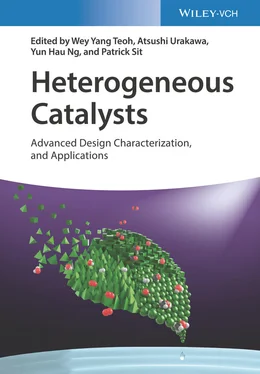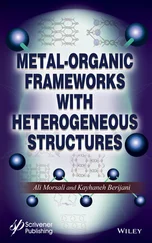3.3 Conclusions and Perspective
Electrochemical route is probably one of the most cost‐effective synthesis methods of functional and nanostructured thin films because it does not require expensive or complicated apparatus. It also offers great versatility in fabricating thin film with various desired properties by simply modulating a few operating parameters. All electrochemical methods discussed in this chapter are based on the same principle of electrochemistry that the deposition is a result of redox reactions and the migration behavior of charged elements given an applied voltage or current (i.e. anodization, cathodic electrodeposition, and electrophoretic deposition). Changing the ways of voltage/current being applied to the system (e.g. through the introduction of pulse) can also have great influence in the quality of the deposition process.
Current status of electrochemical thin film synthesis has seen the domination of catalytic materials with relatively simple composition. In many cases, metal oxides in the form of binary oxides are produced. Modulation of their morphology using electrochemical methods (as described in this chapter) and the subsequent investigation on the impact of such morphological control offer new opportunity in improving the overall reaction kinetics. Recent trend in nanostructuring the catalytic materials in thin film configuration will continue. Electrochemical synthesis of nanostructured catalytic thin film can also offer the opportunities in exploring new catalytic materials beyond the currently dominant simple oxide (or other simple composition). Introduction of secondary component in the making of composite materials and the transformation of simple oxide into ternary/quaternary counterparts may become an apparent alternative in the near future to prepare complex functional catalytic thin films. The matrix of composition afforded by electrochemical synthesis of thin films might also be helpful in discovering new catalytic reactions.
1 1 Mehla, S., Das, J., Jampaiah, D. et al. (2019). Recent advances in preparation methods for catalytic thin films and coatings. Catal. Sci. Technol. 9: 3582–3602.
2 2 Lee, W. and Park, S.‐J. (2014). Porous anodic aluminum oxide: anodization and template synthesis of functional nanostructures. Chem. Rev. 114: 7487–7556.
3 3 Uchiyama, H. (2015). Evaporation‐driven self‐organization of sol–gel dip‐coating films. J. Ceram. Soc. Jpn. 123: 457–464.
4 4 Hunt, H.K., Lew, C.M., Sun, M. et al. (2010). Pure‐silica zeolite thin films by vapor phase transport of fluoride for low‐k applications. Microporous Mesoporous Mater. 128: 12–18.
5 5 Karches, M., Morstein, M., von Rohr, P.R. et al. (2002). Plasma CVD‐coated glass beads as photocatalyst for water decontamination. Catal. Today 72: 267–279.
6 6 Singh, J. and Wolfe, D.E. (2005). Nano and macro‐structured component fabrication by electron beam‐physical vapor deposition (EB‐PVD). J. Mater. Sci. 40: 1–26.
7 7 Sarakinos, K., Alami, J., and Konstantinidis, S. (2010). High power pulsed magnetron sputtering: a review on scientific and engineering state of the art. Surf. Coat. Technol. 204: 1661–1684.
8 8 Nistico, R., Scalarone, D., and Magnacca, G. (2017). Sol–gel chemistry, templating and spin‐coating deposition: a combined approach to control in a simple way the porosity of inorganic thin films/coatings. Microporous Mesoporous Mater. 248: 18–29.
9 9 Mechiakh, R., Sedrine, N.B., Chtourou, R., and Bensaha, R. (2010). Correlation between microstructure and optical properties of nano‐crystalline TiO2 thin films prepared by sol–gel dip coating. Appl. Surf. Sci. 257: 670–676.
10 10 Ojo, A.A. and Dharmadasa, I.M. (2018). Electroplating of semiconductor materials for applications in large area electronics: a review. Coatings 8: 262.
11 11 Kay, A., Cesar, I., and Gratzel, M. (2006). New benchmark for water photooxidation by nanostructured Fe2O3 films. J. Am. Chem. Soc. 128: 15714–15731.
12 12 Brust, M., Bethell, D., Kiely, C.J., and Schiffrin, D.J. (1998). Self‐assembled gold nanoparticle thin films with non‐metallic optical and electronic properties. Langmuir 14: 5425–5429.
13 13 Ung, T., Liz‐Marzan, L.M., and Mulvaney, P. (2001). Optical properties of thin films of Au@SiO2 particles. J. Phys. Chem. B 105: 3441–3452.
14 14 Osaka, T. (1997). Electrochemical formation and microstructure in thin films for high functional devices. Electrochim. Acta 42: 3015–3022.
15 15 Wang, K., Liu, G., Hoivik, N. et al. (2014). Electrochemical engineering of hollow nanoarchitectures: pulse/step anodization (Si, Al, Ti) and their applications. Chem. Soc. Rev. 43: 1476–1500.
16 16 Xiao, F., Hangarter, C., Yoo, B. et al. (2008). Recent progress in electrodeposition of thermoelectric thin films and nanostructures. Electrochim. Acta 53: 8103–8117.
17 17 Besra, L. and Liu, M. (2007). A review on fundamentals and applications of electrophoretic deposition (EPD). Prog. Mater. Sci. 52: 1–61.
18 18 Yun, J.‐Y., Wong, R.J., Ng, Y.H. et al. (2012). Combined electrophoretic deposition–anodization method to fabricate reduced graphene oxide‐TiO2 nanotube films. RSC Adv. 2: 8164–8171.
19 19 Prakasam, H.E., Shankar, K., Paulose, M. et al. (2007). A new benchmark for TiO2 nanotube array growth by anodization. J. Phys. Chem. C 111: 7235–7241.
20 20 Yun, J.‐H., Ng, Y.H., Ye, C. et al. (2011). Sodium fluoride‐assisted modulation of anodized TiO2 nanotube for dye‐sensitized solar cells application. ACS Appl. Mater. Interfaces 3: 1585–1593.
21 21 Ng, C., Ye, C., Ng, Y.H., and Amal, R. (2010). Flower‐shaped tungsten oxide with inorganic fullerene‐like structure: synthesis and characterization. Cryst. Growth Des. 10: 3794–3801.
22 22 Lou, S.N., Yap, N., Scott, J. et al. (2014). Influence of MoO3(110) crystalline plane on its self‐charging photoelectrochemical properties. Sci. Rep. 4: 7428.
23 23 Albu, S.P., Kim, D., and Schmuki, P. (2008). Growth of aligned TiO2 bamboo‐type nanotubes and highly ordered nanolace. Angew. Chem. Int. Ed. 47: 1916–1919.
24 24 Lee, W., Kim, J.‐C., and Gosele, U. (2010). Spontaneous current oscillations during hard anodization of aluminium under potentiostatic conditions. Adv. Funct. Mater. 20: 21–27.
25 25 Sulka, G.D. (2008). Highly Ordered Anodic Porous Alumina Formation by Self‐Organized Anodizing. Weinheim: Wiley‐VCH Verlag GmbH & Co. KGaA. ISBN: 978‐3‐527‐31876‐6.
26 26 Korotcenkov, G. and Cho, B.K. (2010). Silicon porosification: state of the art. Crit. Rev. Solid State Mater. Sci. 35: 153–260.
27 27 Roy, P., Berger, S., and Schumuki, P. (2011). TiO2 nanotubes: synthesis and applications. Angew. Chem. Int. Ed. 50: 2904–2939.
28 28 Chandrasekar, M.S. and Pushpavanam, M. (2008). Pulse and pulse reverse plating – conceptual, advantages and applications. Electrochim. Acta 53: 3313–3322.
29 29 Saji, V.S. (2018). Electrodeposition in bulk metallic glasses. Materialia 3: 1–11.
30 30 Yun, J.‐H., Ng, Y.H., Huang, S. et al. (2011). Wrapping the walls of n‐TiO2 nanotubes with p‐CuInS2 nanoparticles using pulsed‐electrodeposition for improved heterojunction photoelectrodes. Chem. Commun. 47: 11288–11290.
31 31 Tang, Y., Traveerungroj, P., Tan, H.L. et al. (2015). Scaffolding an ultrathin CdS layer on a ZnO nanorod array using pulsed electrodeposition for improved photocharge transport under visible light illumination. J. Mater. Chem. A 3: 19582–19587.
32 32 Tang, Y., Wang, P., Yun, J.H. et al. (2015). Frequency‐regulated pulsed electrodeposition of CuInS2 on ZnO nanorod arrays as visible light photoanodes. J. Mater. Chem. A 3: 15876–15881.
33 33 Ng, C., Iwase, A., Ng, Y.H., and Amal, R. (2012). Transforming anodized WO3 films into visible‐light active Bi2WO6 photoelectrodes by hydrothermal treatment. J. Phys. Chem. Lett. 3: 913–918.
Читать дальше

